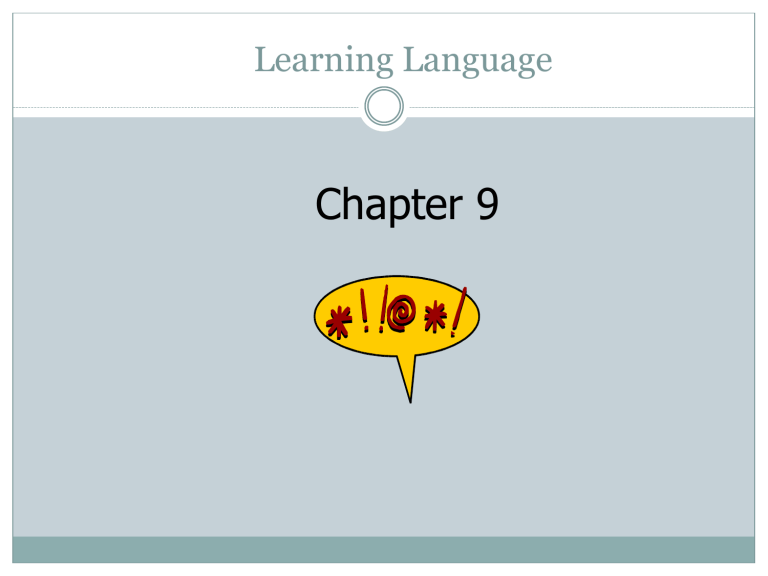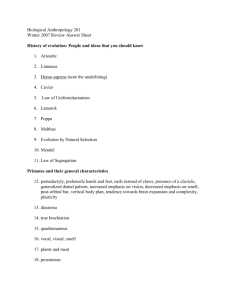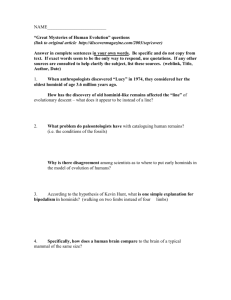Learning Language

Learning Language
Chapter 9
How is Language Possible?
Theories
Defining language
Design Features
Primates
Acquisition of Language
Speech Sounds
When is language possible?…
How is language possible?….
Contemporary Theories
Theoretical linguistics:
Still speculative
Language- evolved at once
Language- innate feature in humans
Children born with universal grammar
Only need to acquire specifics
Linguistic anthropology:
Uses all four fields of anthropology
Language too complicated to have developed all at once
Language probably evolved slowly along with culture
Children born with ability to learn language
Learning takes place in social situations.
Defining Language
Sending
Receiving
Language Communication
Yes
Yes
Responding
Socially learned
Yes
Yes
Complex grammar Yes
Lies, games, etc.
Yes
Yes
Possible
Possible
No
No
No
Defining Language
Hockett’ s Design Features of language
1960s
Defining what is unique to humans
Thirteen features
Four are unique to human language.
Design Features of Language
Not Unique to Humans
Vocal/auditory channel
Broadcast transmission / directional reception
Rapid fading
Interchangeability
Total feedback
Specialization
Semanticity
Arbitrariness
Discreteness.
Unique to Humans:
(according to Hockett)
10.
Displacement
11.
Productivity
12.
Traditional transmission
13.
Duality of patterning
/ k + æ + t + s /.
Design Features and the Emergence of
Human Language
The idea of blending
Combining calls to establish productivity
Starting from closed calls (limited, specific)
A + B = A + B
danger + food = danger + food
Moving to blended calls (prelanguage)
A + B = AB
danger + food = dangerous food breakfast + lunch = brunch
Making duality of patterning possible
Isolation of units for recombining
A + B + C = ABC, CBA, BAC, ACB
Primate Communication
Experiments :
Chimpanzees
Gorillas
Orangutans
What this tells us about language
Duality of patterning is uniquely human
What it tells us about language origins
Pre-language abilities of humans and other primates probably similar.
Acquisition of Language
Development of linguistic ability is linked to maturation of cognitive processes
Sounds as abstract and arbitrary can be used to stand for objects and ideas
Chomsky (p.247):
“speaker’s ability to produce & understand instantly new sentences that are not similar to those previously heard… It seems plain that language acquisition is based on the child’s discovery of what from a formal point of view is a deep & abstract theory- a generative grammar of his/her language”
Jean Piaget & Lev Vygotsky’s theories
Individual cognition & social needs as driving force for language
Children and Language
3 days – recognizing parents’ sounds
3 months – cooing, playing with intonation
6 months – babbling, playing with sounds
9 months – beginning signs
1 year – recognizable spoken words & speak single words (Holophrastic)
15 months – naming “explosion”
2 years – simple sentences, displacement
Then – negatives, questions, clauses.
Theories about Language in Children
Innatist theories
Language hard-wired in brain
Behaviorist theories
Stimulus and reward
Cognitivist theories
Concepts come first
The theory theory
Children observe and build theories
Different languages - different theories?
Complex Grammars
Cognitive development and experiential maturation stimulate children to expand their linguistic abilities
Two important themes:
1.
2.
Development awareness that organization w/in sentences is significant
Transferring learning from one context to others by processes of analogy & rule generalization.
WHEN is Language Possible?
Connected to HOW
Involves research into brain…
And vocal tract…
And origins of culture….
The Human Brain
Cortex
The convoluted surface of the brain
Two millimeters thick
Surface area 1.5 square yards
Contains 100 million neurons
Oldest part of cortex
Controls long term memory
And emotion
Newer part of cortex
“Neocortex”
Controls language
80% of human brain
Divided into lobes
Frontal
Temporal
Parietal
Occipital.
Lateralization & Language
• Two cerebral hemispheres
• Connected by corpus callosum
Left hemisphere
association
calculation analysis language
Right hemisphere
touch
space music contexts for language use.
Language Areas of the Brain
Broca’s area
Clarity of speech
Function words
Some word order
Wernicke’s area
Understanding words
Producing sentences.
The Human Vocal Tract
Lowering of the larynx
Where vocal cords are located
Lengthening of the pharynx
More space for tongue
Increased vowel resonance
Differentiation of vowels: [i] [a] [u]
Human infants born with high larynx
Begins to lower at three months
Reaches adult location by 3-4 years
Except in adult males: further descent at adolescence.
The Fossil Record
Evidence from basicranium
Where muscles attach
More curved = lower larynx
Australopithecus (1.5 mya) not curved
Homo habilis (2 mya) no data
Homo erectus (1.6 mya) some curve
Early Homo sapiens (400,000 ya) definite curve
Homo sapiens sapiens (125,000 ya) ditto
Neanderthal (130,000 ya) no curve.
Origins of Culture
Associating language with complex tools
evolution of tool design provides clues
complexity of Upper Paleolithic tools
requires description (vs imitation)
Associating language with cultural complexity
art, music, ritual, cooperative hunting/childcare.
The Fossil Record
Australopithecus (1.5 mya) first stone tools
Homo habilis (2 mya) control of fire
Homo erectus (1.6 mya) organized hunting?
Early Homo sapiens (400,000 ya) shelters, burials
Homo sapiens sapiens (125,000 ya) knitting, basketweaving
Neanderthal (130,000 ya) burials, music.








